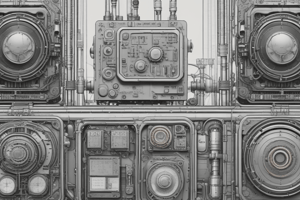Podcast
Questions and Answers
What happens to the reconstructed signal when the number of samples is reduced by half?
What happens to the reconstructed signal when the number of samples is reduced by half?
- The reconstructed signal disappears completely.
- The reconstructed signal remains unchanged.
- The reconstructed signal becomes more accurate.
- The reconstructed signal has missing peaks and dips. (correct)
What is a characteristic of most quantities in nature that can be measured?
What is a characteristic of most quantities in nature that can be measured?
- They are always constant
- They are discrete
- They are continuous (correct)
- They are always zero
What type of electronic systems accept and process continuous signals?
What type of electronic systems accept and process continuous signals?
- Mixed Electronic Systems
- Hybrid Electronic Systems
- Analogue Electronic Systems (correct)
- Digital Electronic Systems
How does the intensity of light change throughout the day?
How does the intensity of light change throughout the day?
What happens when the sampling is increased to infinity?
What happens when the sampling is increased to infinity?
What happens to the light intensity when the sun is obscured by a cloud?
What happens to the light intensity when the sun is obscured by a cloud?
What is the result of under-sampling in signal reconstruction?
What is the result of under-sampling in signal reconstruction?
What is the purpose of electronic processing of continuous and digital quantities?
What is the purpose of electronic processing of continuous and digital quantities?
How does the temperature change during a 24-hour period?
How does the temperature change during a 24-hour period?
How many samples are used to reconstruct the signal in Figure 1.3?
How many samples are used to reconstruct the signal in Figure 1.3?
How does the velocity of a car travelling from one city to another vary?
How does the velocity of a car travelling from one city to another vary?
What is the main difference between the original and reconstructed signals?
What is the main difference between the original and reconstructed signals?
What is characteristic of digital quantities?
What is characteristic of digital quantities?
What is the purpose of sampling a continuous signal?
What is the purpose of sampling a continuous signal?
What happens to a continuous signal when it is represented digitally?
What happens to a continuous signal when it is represented digitally?
What is the set of values (1, 2, 4, 7, 18, 34, 25, 23, 35, 37, 29, 42, 41, 25 and 22) an example of?
What is the set of values (1, 2, 4, 7, 18, 34, 25, 23, 35, 37, 29, 42, 41, 25 and 22) an example of?
Flashcards are hidden until you start studying
Study Notes
Analogue vs Digital Quantities
- Most natural quantities that can be measured are continuous, such as light intensity, temperature, and velocity.
- Continuous quantities change gradually and smoothly over time, with no abrupt changes.
Characteristics of Analogue Quantities
- Have a continuous range of values with a minimum and maximum value.
- Examples: temperature values in a summer month (23°C to 45°C), car velocity (0 to 120 mph).
Digital Representation of Quantities
- Digital quantities are not continuous, but represent quantities measured at discrete intervals.
- A continuous signal is sampled at fixed and equal intervals to obtain digital values.
- The number of samples collected determines the accuracy of the digital representation.
Limitations of Digital Representation
- Fewer samples can lead to a reconstructed signal that is different from the original signal.
- Under-sampling can result in missing peaks and dips in the reconstructed signal.
- Increasing the number of samples and sampling intervals can improve the accuracy of the digital representation.
Electronic Processing of Quantities
- Electronic processing of continuous quantities or their digital representation requires conversion to voltage representations.
- There are two types of electronic processing systems: analogue and digital.
- Analogue electronic systems accept and process continuous signals, while digital electronic systems process discrete digital values.
Studying That Suits You
Use AI to generate personalized quizzes and flashcards to suit your learning preferences.


